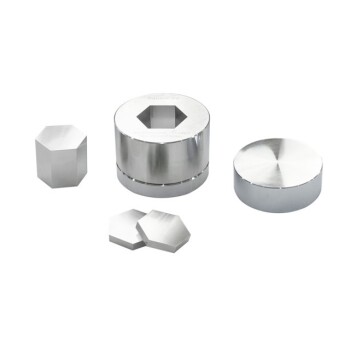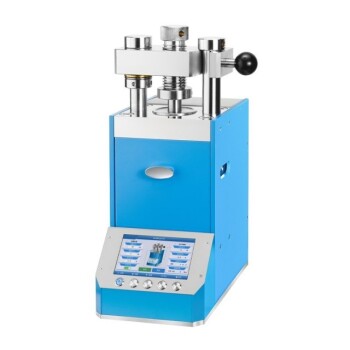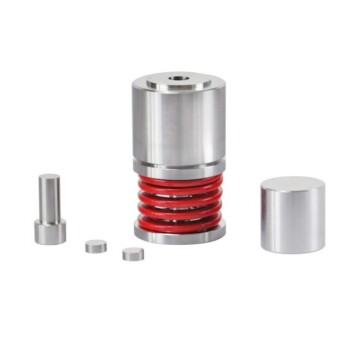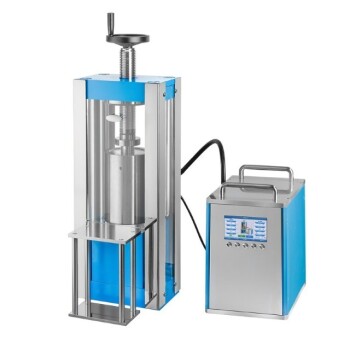In powder metallurgy, the primary role of a hydraulic press is to compact loose powder into a solid, densified form. By applying immense and highly controlled force, the press transforms raw powdered material into a precisely shaped component, known as a "green compact." This process is the foundational step for creating strong, lightweight, and complex parts with specific, engineered properties.
A hydraulic press is more than a shaping tool; it is the critical instrument for controlling a material's final density, strength, and uniformity at a microscopic level. Its ability to apply consistent pressure—often combined with heat—is what transforms loose powder into a high-performance engineered component.
The Core Function: Powder Compaction and Densification
Powder metallurgy begins by turning formless powder into a solid object. The hydraulic press is the machine that makes this initial transformation possible.
From Loose Powder to a "Green" Compact
The process begins by placing a measured amount of powder into a die cavity. The hydraulic press then drives a punch into the die, compressing the powder particles together.
This pressure forces the particles into intimate contact, reducing the voids between them and forming a solid object that is strong enough to be handled. This initial part is called a green compact.
The Importance of Uniform Pressure
A key advantage of a hydraulic press is its ability to apply perfectly uniform pressure. This consistency is critical for producing high-quality parts.
Uneven pressure creates density variations within the compact, which can lead to internal defects, weak spots, or warping during subsequent processing steps like sintering. Uniform pressure ensures the final part has consistent properties throughout.
Achieving Target Density
The amount of force applied directly correlates to the density of the green compact. Higher pressure eliminates more empty space between particles, resulting in a denser, stronger part.
This control allows engineers to precisely dial in the desired density required for a specific application, balancing strength requirements with material usage.
The Role of Heat in Advanced Compaction
While cold pressing is common, adding heat to the process unlocks a higher level of material performance and is essential for creating advanced composites.
Enhancing Densification with Temperature
Using a heated hydraulic press, a process known as hot pressing, makes the powder particles more malleable. This allows them to deform and bond more effectively under pressure.
As a result, hot pressing can achieve significantly higher densities and create parts with fewer internal voids compared to pressing at room temperature.
Improving Mechanical Properties
The combination of heat and pressure fundamentally enhances the final mechanical properties of the material.
This process creates components with superior strength, durability, and wear resistance, making it ideal for high-performance applications in the aerospace, automotive, and industrial sectors.
Creating Advanced Composite Materials
Heated presses are essential for producing composite materials. The press can bond layers of different materials or cure resins mixed with powders.
This results in strong, lightweight, and durable products like specialized ferromagnetic components, custom alloy samples, and other advanced materials.
Understanding the Trade-offs
While powerful, the hydraulic press is not a universal solution. Understanding its limitations is key to successful implementation.
Complexity of Part Geometry
Hydraulic presses excel at producing parts with relatively simple geometries where pressure can be applied uniformly along a single axis.
Highly complex shapes with undercuts or transverse features can be challenging to press evenly, potentially leading to density variations and structural weaknesses.
Cold Pressing vs. Hot Pressing
Cold pressing is faster and less expensive, but the resulting green compacts have lower density and require a significant, energy-intensive sintering step to achieve final strength.
Hot pressing is a slower, more expensive process but produces parts with near-final density and superior properties directly out of the press, often reducing the need for extensive secondary operations.
Beyond Manufacturing: The Press as a Research Tool
In addition to production, hydraulic presses are indispensable tools for material science research and development.
Simulating Extreme Environments
Researchers use hydraulic presses to simulate real-world conditions, such as the extreme pressures found deep underground or in industrial machinery.
This allows them to study material behavior and test properties like elasticity, plasticity, and fracture points without building full-scale prototypes.
Accelerating Material Innovation
By creating small, uniform pellets for analysis, presses enable scientists to rapidly test and iterate on new material formulations. This is crucial for developing novel alloys, polymers, and composites with unique characteristics.
Making the Right Choice for Your Goal
The optimal use of a hydraulic press in powder metallurgy depends entirely on your end goal.
- If your primary focus is high-volume production of simple parts: Cold pressing followed by a separate sintering stage is often the most cost-effective path.
- If your primary focus is achieving maximum density and performance: Hot pressing is the superior method for creating high-strength, near-net-shape components.
- If your primary focus is research and development: A laboratory press is essential for creating uniform test samples and simulating environmental stresses on new material formulations.
Ultimately, mastering the hydraulic press is fundamental to controlling the transformation of simple powder into a precisely engineered material.
Summary Table:
| Aspect | Key Details |
|---|---|
| Primary Role | Compacts loose powder into solid green compacts with controlled force. |
| Key Benefits | Uniform pressure for consistent density, high strength, and complex part shaping. |
| Process Types | Cold pressing (cost-effective) and hot pressing (higher density, superior properties). |
| Applications | Aerospace, automotive, industrial sectors, and material science research. |
Ready to enhance your powder metallurgy processes with reliable hydraulic presses? KINTEK specializes in lab press machines, including automatic lab presses, isostatic presses, and heated lab presses, designed to meet the precise needs of laboratories. Our equipment ensures uniform compaction, improved material density, and accelerated innovation for your research or production goals. Contact us today to discuss how our solutions can benefit your projects and drive efficiency in your operations!
Visual Guide
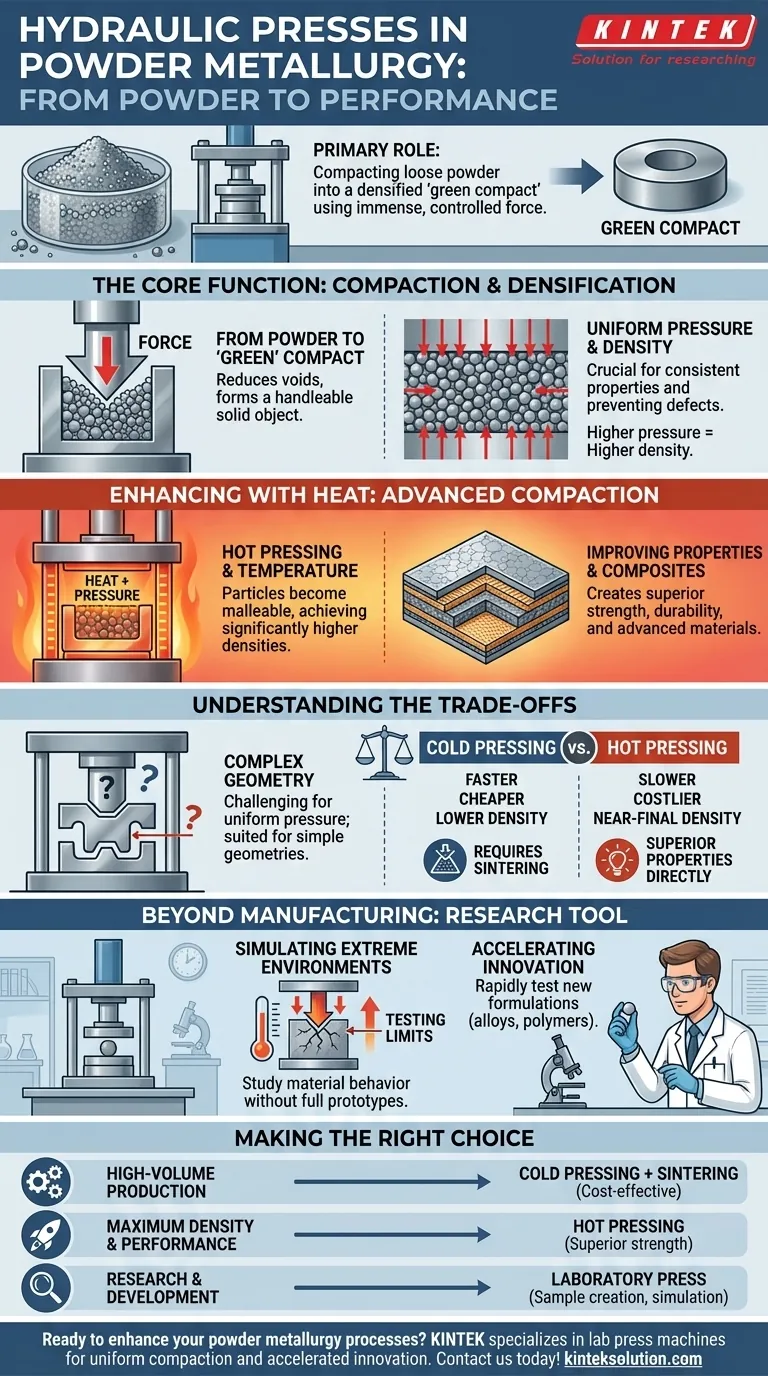
Related Products
- Laboratory Hydraulic Press 2T Lab Pellet Press for KBR FTIR
- Laboratory Hydraulic Press Lab Pellet Press Button Battery Press
- Automatic Laboratory Hydraulic Press Lab Pellet Press Machine
- Automatic Laboratory Hydraulic Press for XRF and KBR Pellet Pressing
- Lab Polygon Press Mold
People Also Ask
- What are the main advantages of using hydraulic presses for sample preparation? Achieve Precise, Uniform Samples for Reliable Analysis
- What is the overall significance of hydraulic presses in laboratories? Unlock Precision and Power for Your Research
- How is a laboratory hydraulic press used in sample preparation for FTIR spectroscopy? Create Transparent Pellets for Accurate Analysis
- What are the benefits of reduced physical effort and space requirements in hydraulic mini presses? Boost Lab Efficiency and Flexibility
- How do hydraulic press machines ensure precision and consistency in pressure application? Achieve Reliable Force Control for Your Lab




